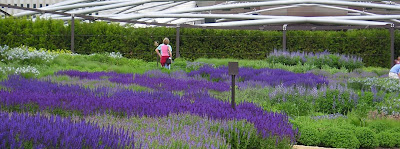I grew up within walking distance of the New York Botanical Gardens (and the Bronx Zoo) and spent many summer afternoons there with my mother and father, picnicking, bike riding and pretending that I was walking through some enchanted garden. As a child, much of my experience with nature was obtained through time spent there and I realize now, over twenty years later, that spending time there is likely what caused me to fall in love with nature and beautiful landscapes. I suppose in a way I owe my pursuit of a degree in landscape architecture to having that garden so near to my home.
Life in the Bronx is on one hand difficult for a child; one has to deal with a fair amount of violence, drugs, peer pressure and sadness. On the other hand, though, if a child is lucky enough they get to experience the positive sides of the Bronx that many people take for granted or simply aren't aware of. The following are some facts and figures from either BOEDC (Bronx Overall Economic Development Corporation) or the Bronx County Historical Society to help you learn a bit more about this forsaken borough:
* The Bronx is known as "THE BOROUGH OF UNIVERSITIES AND PARKS"
* The Bronx has high residential buying power, drawing top business chain stores(K-mart, JC Penney, Home Depot, Old Navy, Modell's, Barnes & Nobel) to neighborhoods
* The Bronx has 11 interstate highways, parkways and expressways
* The Bronx has over 10 bridges - Tri-boro Bridge, Willis Avenue Bridge, MadisonAvenue Bridge, Third Avenue Bridge, Whitestone Bridge, Throgs Neck Bridge, 149 st Bridge, Macomb's Dam Bridge, Washington Bridge, University Heights Bridge and Broadway Bridge
* The Bronx has waterfront access to three major rivers - East River, Harlem River, and Hudson River
* The Bronx has over 8 colleges & universities - Fordham University, Lehman College, Bronx Community College, Hostos Community College, Albert Einstein College of Medicine, College of Mt. Saint Vincent, Mercy College, SUNY Maritime College and Manhattan College
* The Bronx has 1 beach - Orchard Beach
* The Bronx has the only high school (Bronx High School of Science) with an almamater to more Nobel Prize laureates than any other high school in the U.S
* The Bronx has over 60 landmarks and historic districts (one of which is the Botanical Garden)
* The Bronx is responsible for the cultural introduction of rap, salsa, and break-dancing
* The Bronx consists of 43 square miles, 24% of which is parkland
* The Bronx has recreational activities like horseback riding, golfing, sailing, fishing, private tennis courts, swimming and more throughout Van Cortlandt Park, Pelham Bay Park and City Island
* The Bronx has the largest Metropolitan Wildlife Park in the U.S., (The Bronx Zoo/Wildlife Conservation Park) with 265 acres of land and over 4,000 animals
* The Bronx has its own hiking and biking routes called the Bronx Greenway
* The Bronx has its own arts ensemble (Bronx Arts Ensemble), its own opera company (The Bronx Opera Company), and its own symphony (Bronx Symphony)
* The Bronx is the only borough with the word "The" placed before it ("The Bronx" originated from the name of "The Bronx River," which received its name from an early European settler named Jonas Bronck)
Revisiting the Botanical Gardens with my mother and niece this summer after a year of studying landscape architecture has made me that much more grateful and proud of being from the borough with the bad rap. Although our favorite spot to picnic has since been replaced by a vegetable demo garden and the price for admission has moved from a voluntary donation of any amount to $6 for Grounds Only Admission or $20 for an All-Garden Pass, the NYBG is still a fantastic place for visitors of all ages.

"The Garden also offers a sweeping 250-acre landscape, 50 curated display gardens, an expansive 50-acre native forest, and a wealth of programs, exhibitions, and activities for visitors to enjoy. The grounds display masterpieces, some dating to the 1840s, by many of the nation's most accomplished architects and designers, both past and contemporary. The Botanical Garden's innovative programs, unparalleled resources, and talented staff are rivaled by few and exceeded by none" (NYBD Website). The garden is currently featuring a set of works by artist Henry Spencer Moore whose abstract works are displayed around the world. His subject matter is often a reclining woman, a mother and child, or a relationship in nature and typically make reference to the landscape and flowing hills of the countryside. His pieces tend to be quite large in comparison to the human scale and are meant to be viewed from all angles with nature as a constant backdrop.
Next time you're in New York on vacation (does anyone actually do that?), please be sure to venture off of the typical tourist path of Manhattan; visit the Bronx and stop by the NYBG- you'll be glad you did. (By the way, the main entrance of the Bronx Zoo also happens to be right across the street from the garden so you can treat yourself to a twofer.)
-Olivia Alicea

 After a recent summer vacation, I returned home to find my incredibly lovely tomato plants stripped of their life- more than half of the leaves gone, and in their place, horrible, disgusting, nightmare-invoking horn worms.
After a recent summer vacation, I returned home to find my incredibly lovely tomato plants stripped of their life- more than half of the leaves gone, and in their place, horrible, disgusting, nightmare-invoking horn worms.













 To many New Yorkers who have not lived in or frequently visited the Bronx, the worst of the city's five boroughs in terms of crime, poverty and living conditions, is by far the Bronx. Many people might say "that's too bad" when I admit that's where I was born and spent a better part of my childhood. As a child, you aren't always aware of how good or bad of a situation you're in, but as you mature and learn about the world you begin to realize just what the reality of your situation is. Growing up, I knew where I lived wasn't exactly the nicest of places and it certainly wasn't anything like the glitz and glamour of Manhattan, as seen most often on television. With that realization in mind, I still knew where I lived was special, even if no one else did. This summer I was able to go back 'home' and revisit a place that has left a wonderful imprint in my heart and mind.
To many New Yorkers who have not lived in or frequently visited the Bronx, the worst of the city's five boroughs in terms of crime, poverty and living conditions, is by far the Bronx. Many people might say "that's too bad" when I admit that's where I was born and spent a better part of my childhood. As a child, you aren't always aware of how good or bad of a situation you're in, but as you mature and learn about the world you begin to realize just what the reality of your situation is. Growing up, I knew where I lived wasn't exactly the nicest of places and it certainly wasn't anything like the glitz and glamour of Manhattan, as seen most often on television. With that realization in mind, I still knew where I lived was special, even if no one else did. This summer I was able to go back 'home' and revisit a place that has left a wonderful imprint in my heart and mind. "The Garden also offers a sweeping 250-acre landscape, 50 curated display gardens, an expansive 50-acre native forest, and a wealth of programs, exhibitions, and activities for visitors to enjoy. The grounds display masterpieces, some dating to the 1840s, by many of the nation's most accomplished architects and designers, both past and contemporary. The Botanical Garden's innovative programs, unparalleled resources, and talented staff are rivaled by few and exceeded by none" (NYBD Website). The garden is currently featuring a set of works by artist Henry Spencer Moore whose abstract works are displayed around the world. His subject matter is often a reclining woman, a mother and child, or a relationship in nature and typically make reference to the landscape and flowing hills of the countryside. His pieces tend to be quite large in comparison to the human scale and are meant to be viewed from all angles with nature as a constant backdrop.
"The Garden also offers a sweeping 250-acre landscape, 50 curated display gardens, an expansive 50-acre native forest, and a wealth of programs, exhibitions, and activities for visitors to enjoy. The grounds display masterpieces, some dating to the 1840s, by many of the nation's most accomplished architects and designers, both past and contemporary. The Botanical Garden's innovative programs, unparalleled resources, and talented staff are rivaled by few and exceeded by none" (NYBD Website). The garden is currently featuring a set of works by artist Henry Spencer Moore whose abstract works are displayed around the world. His subject matter is often a reclining woman, a mother and child, or a relationship in nature and typically make reference to the landscape and flowing hills of the countryside. His pieces tend to be quite large in comparison to the human scale and are meant to be viewed from all angles with nature as a constant backdrop.
 New York Botanical Gardens Website:
New York Botanical Gardens Website: 














 City Farm is an urban farming initiative by an environmental non-profit in Chicago known as The Resource Center. Its goal is to provide local jobs and affordable, healthy produce for disadvantaged residents. It currently straddles Cabrini Green (a notorious area for failed public housing initiatives, although a new, much improved project opened adjacent to City Farm)and the Gold Coast (one of Chicago's elite neighborhoods). Ongoing gentrification will likely push it out of the community to another vacant lot somewhere, but it is booming right now and receives volunteer labor from all over the city. People willingly give up sat. mornings to help grow food in the city. I bought a cucumber, garlic and some peppers during my visit, and they were delicious and cheap. More info can be learned at
City Farm is an urban farming initiative by an environmental non-profit in Chicago known as The Resource Center. Its goal is to provide local jobs and affordable, healthy produce for disadvantaged residents. It currently straddles Cabrini Green (a notorious area for failed public housing initiatives, although a new, much improved project opened adjacent to City Farm)and the Gold Coast (one of Chicago's elite neighborhoods). Ongoing gentrification will likely push it out of the community to another vacant lot somewhere, but it is booming right now and receives volunteer labor from all over the city. People willingly give up sat. mornings to help grow food in the city. I bought a cucumber, garlic and some peppers during my visit, and they were delicious and cheap. More info can be learned at 






 More images will follow of other parts of the city, but I definitely think these images ask us as landscape architects what we can do to involve other disciplines in our work to design spaces that are not only beautiful works of art, but backdrops to the daily lives of people. Not only can it create richer, layered public spaces, but it also holds a potential to revitalize urban areas into vibrant communities. Thoughts?
More images will follow of other parts of the city, but I definitely think these images ask us as landscape architects what we can do to involve other disciplines in our work to design spaces that are not only beautiful works of art, but backdrops to the daily lives of people. Not only can it create richer, layered public spaces, but it also holds a potential to revitalize urban areas into vibrant communities. Thoughts? 





